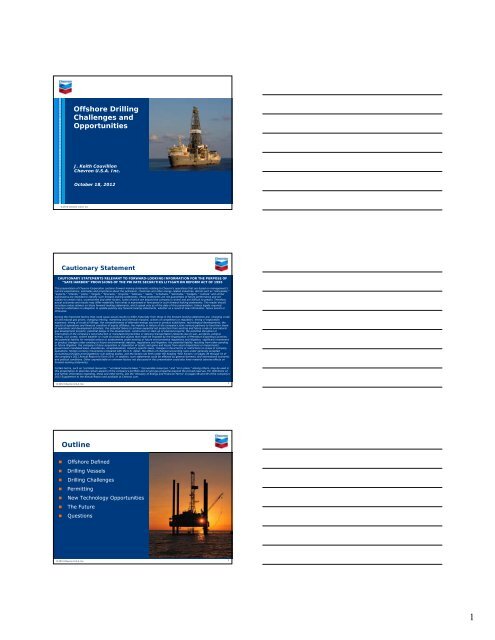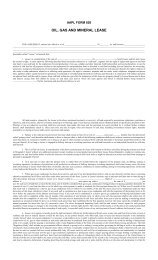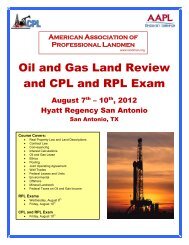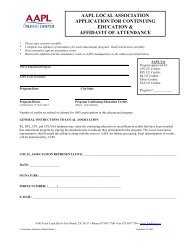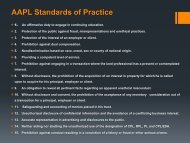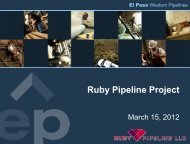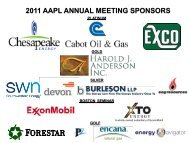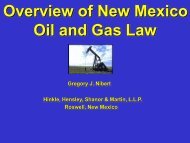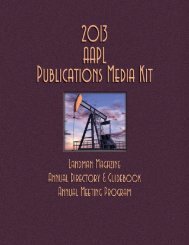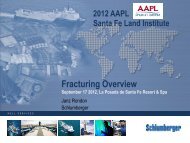Offshore Drilling Challenges and Opportunities Outline
Offshore Drilling Challenges and Opportunities Outline
Offshore Drilling Challenges and Opportunities Outline
You also want an ePaper? Increase the reach of your titles
YUMPU automatically turns print PDFs into web optimized ePapers that Google loves.
<strong>Offshore</strong> <strong>Drilling</strong><br />
<strong>Challenges</strong> <strong>and</strong><br />
<strong>Opportunities</strong><br />
J. Keith Couvillion<br />
Chevron U.S.A. Inc.<br />
October 18, 2012<br />
© 2012 Chevron U.S.A. Inc.<br />
Cautionary Statement<br />
CAUTIONARY STATEMENTS RELEVANT TO FORWARD-LOOKING INFORMATION FOR THE PURPOSE OF<br />
“SAFE HARBOR” PROVISIONS OF THE PRIVATE SECURITIES LITIGATION REFORM ACT OF 1995<br />
This presentation of Chevron Corporation contains forward-looking statements relating to Chevron’s operations that are based on management’s<br />
current expectations, estimates <strong>and</strong> projections about the petroleum, chemicals <strong>and</strong> other energy-related industries. Words such as “anticipates,”<br />
“expects,” “intends,” “plans,” “targets,” “forecasts,” “projects,” “believes,” “seeks,” “schedules,” “estimates,” “budgets,” “outlook” <strong>and</strong> similar<br />
expressions are intended to identify such forward-looking statements. These statements are not guarantees of future performance <strong>and</strong> are<br />
subject to certain risks, uncertainties <strong>and</strong> other factors, some of which are beyond the company’s control <strong>and</strong> are difficult to predict. Therefore,<br />
actual outcomes <strong>and</strong> results may differ materially from what is expressed or forecasted in such forward-looking statements. The reader should<br />
not place undue reliance on these forward-looking statements, which speak only as of the date of this presentation. Unless legally required,<br />
Chevron undertakes no obligation to update publicly any forward-looking statements, whether as a result of new information, future events or<br />
otherwise.<br />
Among the important factors that could cause actual results to differ materially from those in the forward-looking statements are: changing crude<br />
oil <strong>and</strong> natural gas prices; changing refining, marketing <strong>and</strong> chemical margins; actions of competitors or regulators; timing of exploration<br />
expenses; timing of crude oil liftings; the competitiveness of alternate-energy sources or product substitutes; technological developments; the<br />
results of operations <strong>and</strong> financial condition of equity affiliates; the inability or failure of the company’s joint-venture partners to fund their share<br />
of operations <strong>and</strong> development activities; the potential failure to achieve expected net production from existing <strong>and</strong> future crude oil <strong>and</strong> natural<br />
gas development projects; potential delays in the development, construction or start-up of planned projects; the potential disruption or<br />
interruption of the company’s net production or manufacturing facilities or delivery/transportation networks due to war, accidents, political<br />
events, civil unrest, severe weather or crude oil production quotas that might be imposed by the Organization of Petroleum Exporting Countries;<br />
the potential liability for remedial actions or assessments under existing or future environmental regulations <strong>and</strong> litigation; significant investment<br />
or product changes under existing or future environmental statutes, regulations <strong>and</strong> litigation; the potential liability resulting from other pending<br />
or future litigation; the company’s future acquisition or disposition of assets <strong>and</strong> gains <strong>and</strong> losses from asset dispositions or impairments;<br />
government-m<strong>and</strong>ated sales, divestitures, recapitalizations, industry-specific taxes, changes in fiscal terms or restrictions on scope of company<br />
operations; foreign currency movements compared with the U.S. dollar; the effects of changed accounting rules under generally accepted<br />
accounting principles promulgated by rule-setting bodies; <strong>and</strong> the factors set forth under the heading “Risk Factors” on pages 29 through 31 of<br />
the company’s 2011 Annual Report on Form 10-K. In addition, such statements could be affected by general domestic <strong>and</strong> international economic<br />
<strong>and</strong> political conditions. Other unpredictable or unknown factors not discussed in this presentation could also have material adverse effects on<br />
forward-looking statements.<br />
Certain terms, such as “unrisked resources,” “unrisked resource base,” “recoverable resources,” <strong>and</strong> “oil in place,” among others, may be used in<br />
this presentation to describe certain aspects of the company’s portfolio <strong>and</strong> oil <strong>and</strong> gas properties beyond the proved reserves. For definitions of,<br />
<strong>and</strong> further information regarding, these <strong>and</strong> other terms, see the “Glossary of Energy <strong>and</strong> Financial Terms” on pages 58 <strong>and</strong> 59 of the company’s<br />
2011 Supplement to the Annual Report <strong>and</strong> available at Chevron.com.<br />
© 2012 Chevron U.S.A. Inc.<br />
2<br />
<strong>Outline</strong><br />
• <strong>Offshore</strong> Defined<br />
• <strong>Drilling</strong> Vessels<br />
• <strong>Drilling</strong> <strong>Challenges</strong><br />
• Permitting<br />
• New Technology <strong>Opportunities</strong><br />
• The Future<br />
• Questions<br />
© 2012 Chevron U.S.A. Inc.<br />
3<br />
1
<strong>Offshore</strong> Defined<br />
© 2012 Chevron U.S.A. Inc.<br />
4<br />
Government Controlled <strong>Offshore</strong> L<strong>and</strong>s<br />
United States - Exclusive Economic Zone<br />
(3 Billion Acres – 4.1 Million Sq. Miles)<br />
Source: DOI<br />
© 2012 Chevron U.S.A. Inc.<br />
5<br />
Gulf of Mexico Seafloor Bathometry --<br />
Shelf, Deepwater <strong>and</strong> Ultra Deepwater<br />
Louisiana<br />
Texas<br />
© 2012 Chevron U.S.A. Inc.<br />
6<br />
2
Deepwater Gulf of Mexico Bathymetry<br />
Texas<br />
Louisiana<br />
Continental Shelf<br />
Salt Province<br />
Green Canyon<br />
Atwater Valley<br />
Salt Province<br />
Abyssal Plain<br />
Walker Ridge<br />
48 km<br />
30 Miles<br />
© 2012 Chevron U.S.A. Inc.<br />
7<br />
Walker Ridge Area Map<br />
© 2012 Chevron U.S.A. Inc.<br />
8<br />
Deepwater Gulf of Mexico<br />
Technically Challenging Environment<br />
Much of the prospective Gulf of<br />
Mexico deepwater area is covered<br />
by layers of massive salt.<br />
Salt Canopy<br />
6,000’ (1800 m)<br />
7,500’ (2300 m)<br />
US<br />
10000’ (3000 m)<br />
Mexico<br />
© 2012 Chevron U.S.A. Inc.<br />
9<br />
3
Gulf of Mexico Region<br />
© 2012 Chevron U.S.A. Inc.<br />
10<br />
<strong>Drilling</strong> Vessels<br />
© 2012 Chevron U.S.A. Inc.<br />
11<br />
Jack-up <strong>Drilling</strong> Rig<br />
© 2012 Chevron U.S.A. Inc.<br />
12<br />
4
Semi-Submersible <strong>Drilling</strong> Rig<br />
Moored/Anchored<br />
© 2012 Chevron U.S.A. Inc.<br />
13<br />
Semi-Submersible <strong>Drilling</strong> Rig -<br />
Dynamically Positioned<br />
© 2012 Chevron U.S.A. Inc.<br />
14<br />
Drill Ship - Dynamically Positioned<br />
Length - 835 Ft.<br />
Breadth - 125 Ft.<br />
Max. Drill Depth – 35,000 Ft.<br />
Max. Water Depth – 10,000 Ft.<br />
© 2012 Chevron U.S.A. Inc.<br />
15<br />
5
Platform Rig<br />
© 2012 Chevron U.S.A. Inc.<br />
16<br />
<strong>Drilling</strong> <strong>Challenges</strong><br />
© 2012 Chevron U.S.A. Inc.<br />
17<br />
Industry Deep Water Gulf of Mexico<br />
<strong>Drilling</strong> Records<br />
L<strong>and</strong> Rig Platform Rig Jack-up Rig Semi-Submersible Rig Dynamic Positioned Drill Ship<br />
0<br />
Pre 1950<br />
50-54<br />
55-59<br />
60-64<br />
65-69<br />
70-74<br />
75-79<br />
80-84<br />
85-89<br />
90-94<br />
95-99<br />
00-04<br />
05-09<br />
Today<br />
Future<br />
5000<br />
Water Depth<br />
Water Depth Record (’03) 10,011 ft<br />
Depth (ft)<br />
10000<br />
15000<br />
20000<br />
25000<br />
In the middle of last century the industry<br />
started exploring below the worlds oceans.<br />
Since then new technology has consistently<br />
pushed the industry into deeper water depths<br />
<strong>and</strong> total drilled depths.<br />
Water Depth Record (’08) 10,139 ft<br />
<strong>Offshore</strong><br />
<strong>Offshore</strong><br />
Exploration<br />
Exploration<br />
<strong>Drilling</strong><br />
<strong>Drilling</strong><br />
TD<br />
TD<br />
Total Drilled Depth<br />
Current Rig Capability 12,000 ft<br />
30000<br />
35000<br />
40000<br />
Records continue to be broken with current 6 th<br />
Generation drill ships able to drill in 12,000 ft<br />
water depth <strong>and</strong> to 40,000 ft total depth.<br />
<strong>Drilling</strong> Depth Record (’09) 35,955 ft<br />
Current Rig Capability 40,000 ft<br />
© 2012 Chevron U.S.A. Inc.<br />
18<br />
6
Industry Deep Water Gulf of Mexico<br />
Subsalt <strong>Drilling</strong><br />
L<strong>and</strong> Rig Platform Rig Jack-up Rig Semi-Submersible Rig Dynamic Positioned Drill Ship<br />
0<br />
Pre 1950<br />
50-54<br />
55-59<br />
60-64<br />
65-69<br />
70-74<br />
75-79<br />
80-84<br />
85-89<br />
90-94<br />
95-99<br />
00-04<br />
05-09<br />
Today<br />
Future<br />
Depth (ft)<br />
5000<br />
10000<br />
15000<br />
20000<br />
25000<br />
30000<br />
35000<br />
It wasn’t until the early 1980’s that<br />
explorers started looking for oil below<br />
salt. With the advancement of seismic<br />
imaging <strong>and</strong> drilling technology the<br />
industry has been successfully pushing<br />
these limits deeper.<br />
Most of the Wilcox reserves in DW GOM<br />
are covered by a salt canopy, in some<br />
cases up to 20,000 ft thick.<br />
Salt drilled<br />
Will we continue to find reserves below thicker sect tions of salt<br />
40000<br />
© 2012 Chevron U.S.A. Inc.<br />
19<br />
Technology is Pushing the Envelope on<br />
Water Depths<br />
Transocean Deepseas<br />
In 7,000’ of water <strong>and</strong> five<br />
miles below the seabed<br />
<strong>Drilling</strong> in depths that only yesterday seemed impossible…<br />
© 2012 Chevron U.S.A. Inc.<br />
20<br />
Ultra-deep Water Gulf of Mexico<br />
<strong>Drilling</strong> Technical <strong>Challenges</strong><br />
Storms <strong>and</strong> hurricanes<br />
Sea Level<br />
8,000’<br />
Empire State<br />
Building ~500<br />
Meters<br />
Gulf of<br />
Mexico<br />
Suprasalt<br />
Sediment<br />
Loop <strong>and</strong> eddy currents cause<br />
vortex induced vibrations <strong>and</strong><br />
motions to drill strings<br />
Unpredictable high pressure gas<br />
charged stringers <strong>and</strong> faults<br />
near surface<br />
16,000’<br />
Allochthonous Sigsbee<br />
Salt Canopy<br />
Mobile/flow-able/dissolvable<br />
10,000 000’ thick salt canopy with<br />
unpredictable layers of highly<br />
variable trapped sediments<br />
24,000’<br />
Upper Tertiary<br />
Sediments<br />
Unpredictable base of salt –<br />
rapid pressure differentials<br />
32,000’<br />
Lower<br />
Tertiary<br />
Cretaceous<br />
Autochthonous Salt<br />
“Thief zones” of significantly<br />
lower pressure which cause lost<br />
circulation – fluid loss<br />
Ultra-deep reservoir with high<br />
temperatures, high pressures<br />
<strong>and</strong> low natural flow-ability<br />
40,000’<br />
Basement<br />
© 2012 Chevron U.S.A. Inc.<br />
21<br />
7
Permitting<br />
© 2012 Chevron U.S.A. Inc.<br />
22<br />
<strong>Offshore</strong> Event<br />
(BP’s Macondo Prospect)<br />
An explosion <strong>and</strong> fire occurred on the Deepwater Horizon on<br />
April 20, 2010 in the US Gulf of Mexico, about 52 miles<br />
southeast of Venice, LA. The Horizon was engaged in drilling<br />
activity on behalf of BP at Mississippi Canyon Block 252. Eleven<br />
people were lost. The Deepwater Horizon sank on April 22,<br />
2010 in nearly 5,000 ft of water.<br />
Transocean Horizon<br />
Response Fleet<br />
© 2012 Chevron U.S.A. Inc.<br />
23<br />
Subsea BOP<br />
LMRP –<br />
Lower Marine<br />
Riser<br />
Package<br />
Annular<br />
Control POD<br />
60 feet tall<br />
620,000 lbs<br />
Ram Bodies<br />
© 2012 Chevron U.S.A. Inc.<br />
24<br />
8
Ram BOPs<br />
Insert<br />
Photo<br />
Blind Shear Ram<br />
shears smaller tubulars <strong>and</strong> then seals<br />
wellbore (or seals wellbore with no pipe)<br />
Insert<br />
Photo<br />
Casing Shear Ram<br />
shears large tubulars – does not seal<br />
Insert<br />
Photo<br />
Pipe Ram<br />
seals annulus around various drill<br />
pipe sizes<br />
© 2012 Management Chevron U.S.A. Committee Inc. May 2010 25<br />
BOP Emergency Systems<br />
1. Emergency Disconnect<br />
2. Deadman<br />
1 3. Autoshear<br />
2 4. Remotely Operated 4<br />
Vehicle (ROV)<br />
3<br />
Primary Methods to Secure the Well:<br />
• Emergency Disconnect System (EDS)<br />
• Autoshear/Deadman Backup<br />
• ROV Tertiary Intervention<br />
© 2012 Chevron U.S.A. Inc.<br />
26<br />
New Regulations – Worst Case Discharge<br />
(WCD) Casing Design<br />
Pre-Macondo<br />
Post-Macondo<br />
SW<br />
Gas<br />
Oil Gradient<br />
Mud<br />
© 2012 Chevron U.S.A. Inc.<br />
27<br />
9
GOM Deepwater Well Complexity<br />
A Bird’s Eye View<br />
Gulf of Mexico Deepwater<br />
Casing Program:<br />
36” – 7 3/4”<br />
Conventional Deepwater<br />
Casing Program:<br />
30” – 7”<br />
© 2012 Chevron U.S.A. Inc.<br />
28<br />
WCD Casing Design - <strong>Challenges</strong><br />
• Dynamic <strong>Drilling</strong> Casing Loads<br />
SW<br />
• Thermal Annular Pressure Build-Up from WCD<br />
• Deep Collapse from WCD<br />
• Thermal induced upward forces on hanger from WCD<br />
• Approach load limits of most rigs due to heavier wall pipe<br />
Oil Gradient<br />
• Extreme Cement Hydraulics<br />
• Tight annulus for circulation<br />
• Centralization near impossible<br />
• Approach limit of software<br />
• Casing Points<br />
• WCD flow - causing deep collapse <strong>and</strong> formation broaching<br />
• Hole size<br />
© 2012 Chevron U.S.A. Inc.<br />
29<br />
Well Containment<br />
Marine Well Containment Company<br />
‣ 10 Members (Chevron, ExxonMobil,<br />
Shell, ConocoPhillips, etc…)<br />
‣ Rapid response system available to<br />
capture <strong>and</strong> contain oil in the event of a<br />
potential underwater well blowout<br />
‣ The system will be flexible <strong>and</strong> able to<br />
begin mobilization within 24 hours <strong>and</strong><br />
can be used on a wide range of well<br />
designs <strong>and</strong> equipment, oil <strong>and</strong> natural<br />
gas flow rates <strong>and</strong> weather conditions.<br />
‣ The interim system (15,000 psig capping<br />
stack) is engineered to be used in<br />
deepwater depths up to 10,000’ <strong>and</strong><br />
have initial capacity to contain 60,000<br />
barrels & 120 MMCFG per day with<br />
potential for expansion.<br />
© 2012 Chevron U.S.A. Inc.<br />
Helix Well Containment Group<br />
‣22 Members<br />
‣Operate in up to 8,000 feet of water<br />
‣10,000 & 15,000 psig capping stacks<br />
‣Intervention equipment to cap <strong>and</strong><br />
contain a well<br />
‣Capture <strong>and</strong> process 55,000 BOPD & 95<br />
MMCFPD<br />
30<br />
10
Well Construction Impacts<br />
• Extended time required for<br />
internal well planning<br />
• Was ~21-27 weeks<br />
• Now ~27-36 weeks =<br />
New Norm<br />
• Extended time required to<br />
receive permit approvals<br />
• Was ~14-21 days<br />
• Now ~30-45 days or<br />
more = New Norm<br />
© 2012 Chevron U.S.A. Inc.<br />
31<br />
Optimistic Permitting<br />
Timeline Estimates<br />
1 2 3 4 5 6 7 8 9 10 11 12<br />
Pre-incident Developed<br />
Application<br />
Plan Approval/<br />
Permit Approval<br />
MMS EP<br />
Approval<br />
• Usually CE or EA-FONSI<br />
• State consistency review<br />
duration
Permitting <strong>Challenges</strong><br />
• Notices to Lessees<br />
• New Rules<br />
• New Legislation<br />
• Higher Level of Scrutiny<br />
• Oil Pollution Act<br />
• National Environmental Policy Act<br />
• Coastal Zone Management Act<br />
• Endangered Species Act<br />
• Marine Mammal Protection Act<br />
© 2012 Chevron U.S.A. Inc.<br />
34<br />
New Technology <strong>Opportunities</strong><br />
© 2012 Chevron U.S.A. Inc.<br />
35<br />
Technology Enhancement Objectives<br />
• Identify technologies that can be<br />
developed <strong>and</strong> applied which will have<br />
a reasonable opportunity to:<br />
reduce the ranges of key<br />
uncertainties<br />
enhance safe operations <strong>and</strong><br />
environmental protection<br />
increase rig efficiency<br />
lower non-productive rig time<br />
• The goal of implementing new<br />
technologies is to ensure the<br />
successful execution of offshore well<br />
operation<br />
© 2012 Chevron U.S.A. Inc.<br />
36<br />
12
New Deep Water Drillships<br />
• Most advanced drilling<br />
capabilities<br />
• Dynamically positioned,<br />
with double-hull<br />
• Two drilling systems<br />
in a single derrick<br />
• Stronger <strong>and</strong> more efficient<br />
top drive so wells can be<br />
drilled deeper<br />
• Other unique features will<br />
target drilling wells up to<br />
40,000 feet of total depth<br />
Transocean’s Discoverer Clear Leader<br />
• Variable deck load of over 20,000 metric tons; capable<br />
of drilling in water depths of up to 12,000 feet<br />
© 2012 Chevron U.S.A. Inc.<br />
37<br />
Effective <strong>Drilling</strong> <strong>and</strong> Completions<br />
Optimizing Performance<br />
<strong>Drilling</strong> <strong>and</strong> Completions<br />
Technology Today<br />
Integrated technology solution<br />
• Seismic imaging<br />
• Reservoir modeling<br />
• Rock mechanics<br />
• <strong>Drilling</strong> operations<br />
• Real-time monitoring<br />
(Live video camera<br />
<strong>and</strong> feed from rig)<br />
© 2012 Chevron U.S.A. Inc.<br />
38<br />
<strong>Drilling</strong> <strong>and</strong> Completion Technology<br />
Enhancement (near term)<br />
• Risers (esp. High Pressure<br />
<strong>and</strong> High Temperature)<br />
• Managed pressure drilling<br />
• Dual gradient drilling<br />
• Sonic Bit Monitoring<br />
• High strength light weight<br />
cements<br />
• Single trip multi-zone frac<br />
packs completions<br />
© 2012 Chevron U.S.A. Inc.<br />
39<br />
13
Dual Gradient <strong>Drilling</strong><br />
• Dual Gradient <strong>Drilling</strong> (DGD) is a<br />
step-change deepwater drilling<br />
technology that should enhance<br />
safety <strong>and</strong> environmental<br />
performance, as well as drilling<br />
performance.<br />
• Awareness of these potential<br />
benefits led to the technology’s<br />
development in the late 1990’s by<br />
a consortium of industry<br />
operators, drilling contractors <strong>and</strong><br />
service companies.<br />
© 2012 Chevron U.S.A. Inc.<br />
40<br />
Definitions<br />
Managed Pressure <strong>Drilling</strong> (MPD) is an adaptive drilling process used to<br />
precisely control the annular pressure profile throughout the wellbore. The<br />
objectives are to ascertain the downhole pressure environment limits <strong>and</strong><br />
to manage the annular hydraulic pressure profile accordingly. It is the<br />
intention of MPD to avoid continuous influx of formation fluids to the<br />
surface. Any influx incidental to the operation will be safely contained<br />
using an appropriate process.<br />
Dual Gradient <strong>Drilling</strong> (DGD) is one of the 4 variations of MPD. It is the<br />
creation of multiple pressure gradients within select sections of the<br />
annulus to manage the annular pressure profile. Methods include use of<br />
pumps, fluids of varying densities, or combination of these.<br />
SubSea MudLift <strong>Drilling</strong> is the method of DGD developed by the SubSea<br />
MudLift <strong>Drilling</strong> Joint Industry Project from 1996 until 2001. The<br />
project resulted in Industry’s first successful DGD well. The core<br />
technology is the MudLift Pump (MLP). Now made by GE Oil <strong>and</strong> Gas,<br />
this pump has been renamed the MaxLift 1800 Pump (still MLP).<br />
© 2012 Chevron U.S.A. Inc.<br />
41<br />
Dual Gradient <strong>Drilling</strong><br />
- Comparison<br />
With DGD, we Literally<br />
replace the mud in the<br />
drilling riser with a<br />
seawater-density fluid <strong>and</strong><br />
use a denser mud below<br />
the mudline.<br />
Single<br />
Mud<br />
Weight<br />
Conventional<br />
Heavier Mud w/<br />
Seawater<br />
Density Above<br />
Mudline<br />
Dual Gradient<br />
Same Bottom<br />
Hole<br />
Pressure<br />
© 2012 Chevron U.S.A. Inc.<br />
42<br />
14
DGD - Production Benefits<br />
Fewer strings of casing<br />
can lead to larger casing at<br />
TD. Higher rate, designer<br />
completions, for example,<br />
horizontal or multi-lateral<br />
wells, may then become<br />
possible.<br />
This can lead to higher rate<br />
wells <strong>and</strong> higher recovery<br />
factors in deepwater<br />
reservoirs.<br />
36 36<br />
26 SWF Zone<br />
20<br />
22<br />
16<br />
(Conventional)<br />
13-3/8<br />
11-3/4<br />
9-5/8<br />
7-5/8<br />
5-1/2"<br />
Tubing<br />
7" Tubing<br />
9-5/8<br />
(Dual Gradient<br />
(SubSea<br />
<strong>Drilling</strong>)<br />
MudLift)<br />
13-3/8<br />
5-1/2<br />
© 2012 Chevron U.S.A. Inc.<br />
43<br />
Conventional (Single Gradient) vs. Dual-<br />
Gradient <strong>Drilling</strong><br />
Surface<br />
• Formation Pressures (FP) <strong>and</strong><br />
Formation Strengths (FS) are<br />
functions of the weight of the<br />
water <strong>and</strong> sediments above them.<br />
• In deepwater, the lower density<br />
seawater can dominate FP <strong>and</strong><br />
FS.<br />
• Conventional drilling uses a single<br />
density fluid to manage FP <strong>and</strong><br />
FS.<br />
• Dual Gradient <strong>Drilling</strong> uses two<br />
fluids: seawater density above<br />
the seabed, <strong>and</strong> a higher density<br />
fluid below the seabed.<br />
• This is more in harmony with<br />
natural pressure profiles.<br />
© 2012 Chevron U.S.A. Inc. 44<br />
SubSea MudLift <strong>Drilling</strong><br />
A sea-water driven positive<br />
displacement pump is<br />
located above the<br />
BOP/LMRP. It withdraws<br />
the mud from the well <strong>and</strong><br />
pumps it back to the<br />
surface through a line<br />
attached to the drilling<br />
riser.<br />
Pacific<br />
Santa<br />
Ana<br />
<strong>Drilling</strong> Riser<br />
Cross-<br />
Section<br />
Subsea<br />
Rotating<br />
Device<br />
(SRD)<br />
Choke<br />
Line<br />
Seawater Power<br />
Line<br />
Drill<br />
Pipe Kill<br />
Line<br />
Mud Return<br />
Line<br />
The riser is filled with a<br />
seawater-density fluid.<br />
Solids<br />
Processing Unit<br />
(SPU)<br />
A Subsea Rotating Device<br />
(SRD) sits above the<br />
MaxLift Pump which can be<br />
used to rapidly change the<br />
pressure profile in the well.<br />
MaxLift Pump<br />
(MLP)<br />
Drill String<br />
Valve (DSV)<br />
© 2012 Chevron U.S.A. Inc.<br />
45<br />
15
The Heart of the System: MaxLift 1800 Pump<br />
(MLP)<br />
• Positive Displacement Pump installed above<br />
BOP<br />
• Pumps drilling mud from sea floor up mud<br />
return line to rig for processing<br />
• Driven hydraulically by conventional mud<br />
pumps converted for seawater installed on<br />
the rig <strong>and</strong> available for maintenance<br />
• Powered by seawater which is returned to<br />
sea<br />
• Two interchangeable mirror image Triplex<br />
modules<br />
• Pump can be broken into ~ 50 MT lifts for<br />
initial lift onto rig<br />
(Specifications)<br />
80 gallon chambers<br />
1800 gpm max rate<br />
10,000’ WD rating<br />
Up to 18.5 ppg mud<br />
Size - 18’ x 18’ x 30’<br />
Weight - 450,000 lbs<br />
Max Cutting Size - 1.5 in<br />
Triplex<br />
Pump<br />
Modules<br />
HPU’s<br />
Valve<br />
Manifold<br />
© 2012 Chevron U.S.A. Inc.<br />
46<br />
Dual Gradient Advantages<br />
‣ Dual Gradient <strong>Drilling</strong> is a step-change deepwater<br />
drilling technology that has been under development<br />
for over 15 years.<br />
‣ DGD has the ability to enhance drilling safety,<br />
efficiency <strong>and</strong> environmental performance.<br />
‣ DGD can lead to improved deepwater production<br />
<strong>and</strong> reservoir recovery.<br />
© 2012 Chevron U.S.A. Inc.<br />
47<br />
Well Construction<br />
Sonic Bit Monitoring (Accusound & Inficomm)<br />
• Advance preparation for operational changes that<br />
mitigate non-productive time (NPT) encountered above,<br />
within <strong>and</strong> below the salt canopy<br />
• Capture <strong>and</strong> transmit high frequency acoustic<br />
signatures from the drill bit to the surface in real-time<br />
Sonic signature measures bit/bearing wear, actual weight<br />
on bit, <strong>and</strong> formation changes developed by Accusound<br />
Transmission to surface using a new electromagnetic<br />
pulse (EMP) technology commercially developed by<br />
Inficomm<br />
© 2012 Chevron U.S.A. Inc.<br />
48<br />
16
Sonic Bit Monitoring<br />
Gulf of Mexico<br />
Post-Salt<br />
Sediment<br />
High Pressure Gas Stringer<br />
Sigsbee Salt<br />
Canopy<br />
Unpredictable Top<br />
<strong>and</strong> Base<br />
Trapped Sediments<br />
Non-Productive<br />
Time (NPT)<br />
Pre-Salt<br />
Sediment<br />
Ultra Deep Reservoir<br />
Thief Zone (loss circulation)<br />
© 2012 Chevron U.S.A. Inc.<br />
49<br />
Sonic Bit Monitoring<br />
Gulf of Mexico<br />
Inficomm<br />
Post-Salt<br />
Sediment<br />
Sigsbee Salt<br />
Canopy<br />
Trapped Sediments<br />
High Pressure Gas Stringer<br />
Accusound<br />
Unpredictable Top<br />
<strong>and</strong> Base<br />
Pre-Salt<br />
Sediment<br />
Thief Zone (loss circulation)<br />
Ultra Deep Reservoir<br />
© 2012 Chevron U.S.A. Inc.<br />
50<br />
Well Construction<br />
High Strength, Light Weight Cements<br />
• Geo-polymer <strong>and</strong> graphite<br />
reinforced light weight<br />
cements with very high<br />
strengths <strong>and</strong> very low<br />
permeability<br />
• New cements could:<br />
• minimize the effects of<br />
lost circulation zones<br />
• drilling mud<br />
contamination<br />
• problems associated with<br />
placement techniques<br />
© 2012 Chevron U.S.A. Inc.<br />
51<br />
17
High Strength, Light Weight Cements<br />
Conventional<br />
Cement Job<br />
© 2012 Chevron U.S.A. Inc.<br />
52<br />
High Strength, Light Weight Cements<br />
Restricted Clearances<br />
Conventional<br />
Cement Job<br />
<strong>Drilling</strong> Mud Contamination<br />
Loss Circulation<br />
© 2012 Chevron U.S.A. Inc.<br />
53<br />
High Strength, Light Weight Cements<br />
Polymerizes with<br />
temperature or<br />
time<br />
Designer Cements<br />
•Geo-polymer<br />
•Graphite<br />
•Other non-Portl<strong>and</strong><br />
© 2012 Chevron U.S.A. Inc.<br />
54<br />
18
The Future<br />
© 2012 Chevron U.S.A. Inc.<br />
55<br />
Summary<br />
• Advances in technology<br />
have allowed industry to<br />
drill <strong>and</strong> produce offshore<br />
resources safely.<br />
• Many technical challenges<br />
remain to be solved, but<br />
the industry is focused on<br />
finding solutions.<br />
© 2012 Chevron U.S.A. Inc.<br />
56<br />
“The <strong>Offshore</strong> <strong>Drilling</strong> New Normal”<br />
• Rebuilding government<br />
confidence<br />
• Assurance future incidents will<br />
be minimized<br />
• Greater worker <strong>and</strong><br />
environmental safety<br />
• Enhanced well containment <strong>and</strong><br />
spill response<br />
© 2012 Chevron U.S.A. Inc.<br />
57<br />
19
Questions <br />
© 2012 Chevron U.S.A. Inc.<br />
58<br />
20


